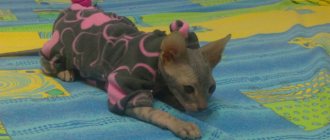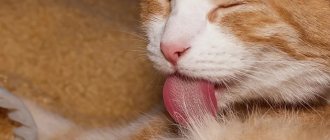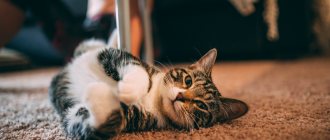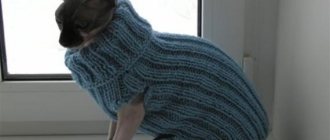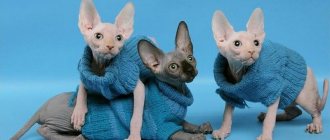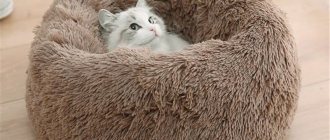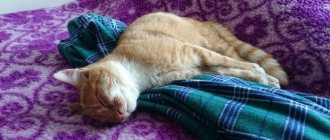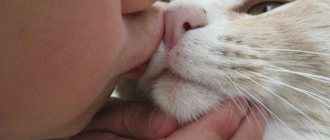Surely, many people think that clothes should be purchased only for dogs. This is not actually the case, and there are many different options for cats. First of all, this applies to short-haired and bald representatives. They freeze quite quickly, so you definitely need to take care of their health. The rest will also need insulated clothing. After all, it will protect the animal from drafts and hypothermia, and will also be especially relevant after surgery and for nursing mothers.
Clothes for cats - necessity or whim?
Even the ancient Egyptians used clothing for cats. It was in Egypt that cats were especially revered and valued. They were given precious stones, delicious food and expensive clothes as gifts. Despite the fact that the deification of cats remains in the distant past, some features of their maintenance have survived to this day.
It is necessary to dress pets not only for the sake of beauty or the whim of the owner, but also to protect the body from hypothermia, overheating, precipitation and drafts. Of course, not all four-legged friends will need items of clothing: some breeds have a thick coat and thick undercoat, so they do not need insulation. The same cannot be said about Sphynxes and smooth-haired cats; they need protection from the harsh Russian winters.
Also included in the vulnerable category are kittens, old pets and animals that have undergone surgical operations with extensive clipping of areas of fur.
In any case, a blanket is put on your four-legged friend after surgery to prevent the animal from licking or scratching the wound. In this case, the medical bandage also protects the cat from cold and drafts.
Sphinxes are dressed not only in winter, but also in summer. To protect pets from the scorching sun, cotton T-shirts are used. If this is not done, the skin of Sphynxes and Levkoys will become dry and covered with spots.
Clothing saves cats that are accustomed to walking outside not only from precipitation, but also from fur contamination and parasites. In the latter case, there is no 100% guarantee of protection, but protective overalls significantly reduce the risk of disease. To protect a cat from accidental relationships with other animals, you can also put a protective suit on it, and then the owner will not have to solve the problem with kittens.
Some owners dress up their pets in beautiful holiday outfits, which in everyday life are not entirely comfortable for constant wear. As a rule, this is done for participation in exhibitions and photo shoots.
Vest without pattern
To sew a vest for a cat, it is not necessary to draw complex patterns. All you need is an old sweater, scissors and some creative inspiration. The model in the picture shows a dog, but the proposed accessory is perfect for a cat of any breed.
Clothing suitable for both cats and miniature dogs
The step-by-step production of such a vest is presented below:
- the sleeve is cut off from a knitted sweater;
- draw a curved line with chalk next to the cut - on the stomach the vest should be shorter than on the back;
- cut off the excess along the marked line and overcast the edge. You can use either an overlocked hand stitch or an overlock stitch;
- The future vest is applied to the animal and the location of the holes for the paws is marked. The closer to the narrow edge the holes are made, the smaller the vest collar will be;
- Having folded the sleeve in half, reflect the marks for the holes symmetrically and cut them out. You can overcast the edge in any way.
After fitting, the craft is adjusted. If necessary, it can be sutured.
Video - Vest for walking
Materials and requirements
The main materials in the manufacture of clothing for cats are:
- cotton and linen fabrics, calico - ideal for sewing summer clothes. Thanks to excellent thermoregulation, the animal feels good, even on the hottest summer day. The only negative is that after washing the clothes shrink and become very wrinkled;
- synthetic materials are ideal for sewing elegant holiday costumes. This type of material is not used for everyday wear due to low air permeability;
- wool, knitwear - for winter clothing options. For example, mohair has high breathability and provides excellent warmth and does not cause allergies in pets.
The material of things intended for walking is combined - for example, water-repellent fabrics are combined with padding polyester filling. These fabrics are easy to wash, dry quickly and practically do not wrinkle. The top layer of clothing (especially for spring and autumn) is made of bolognese fabric or raincoat. It perfectly repels moisture and protects the animal's fur from dirt.
For everyday clothing, it is necessary to select lightweight fabrics that will not hinder the animal’s movements. If the material of the costume clings or causes any discomfort, the pet may be injured during active games.
Home clothes for daily use must meet the following requirements:
- easy to wash;
- fabrics must be durable and light. During wearing, cats often cling to clothes with their claws, and in order not to tear the outfit, the material must be strong enough;
- a minimum of accessories (i.e., exclude the presence of an excessive number of rivets, buttons, zippers, fasteners and ruffles);
- seams and fasteners must be hidden. Buttons should not be sewn on at all; the animal can tear them off and swallow them.
How to choose a cat costume in a store
Clothes for four-legged pets can be bought in the store. The retail chain offers a wide variety of cat apparel. The most common among them:
- One-piece overalls with a cutout for the head, paws, and tail. This walking suit retains heat better than others.
- An autumn-winter version of jackets that cover the main part of the body.
- Sweaters, vests. You can knit such things yourself using patterns, of which there are many on the Internet.
- Shirts, pajamas, T-shirts. They are worn in spring and summer, when dangerous ticks are especially active.
- Accessories, including: blankets, hats, socks.
The cost of clothing for tailed animals ranges from 140 to 1500 rubles. Costumes for exhibitions and holidays can cost more than 2-3 thousand rubles.
Specialized stores have a large assortment of cat clothing and accessories.
In stores you can buy sets of clothes of different sizes, including for kittens.
Material selection
The material is of considerable importance when choosing an outfit for a cat. Autumn overalls can be made of smooth satin, thin fleece and have a lining. Sweaters are made from wool (usually rabbit, but preferably angora). The material for all kinds of blankets and hats can be linen, chintz, and cotton.
Clothing made from natural wool warms a cat well, but it should not be itchy, so choose outfits made from rabbit or angora down.
You need to choose things with a small number of seams, there should not be many buttons or zippers. Many accessories can rub the animal’s skin, cling to the fur and cause inconvenience, especially for active cats during movements.
How to choose the size
Knowing the right size will make the task much easier. Large and small clothes are equally inconvenient for your pet, and he may simply refuse to wear them.
Are the clothes comfortable?
Any outfit should not cause inconvenience to its owner when worn. To check this, you need to run the wrong side of the product over your cheek. If the clothing does not cause any irritation, then it will suit the cat.
Cat outfits
Manufacturers of pet products, in addition to food, vitamins and other paraphernalia, also offer a wide selection of outfits. For example:
- Overalls, jackets and raincoats are protective clothing for your four-legged friend from cold, rainy and dirty weather.
- T-shirt, shirt - suitable for use at home or in warmer months. This type of clothing protects your pet from excessive overheating and harmful parasites (ticks, mosquitoes and fleas);
- A blanket and vest are an indispensable outfit for walks or during the postoperative period;
- Bathrobe - put on the pet after a bath and water procedures;
- Protective body – prevents accidental mating of a cat with a male;
- Original suits and dresses – for exhibitions and photo sessions;
- Hats and boots - used either in cold, dirty weather, or for exhibitions and photo shoots.
Airy skirt
Clothes for cats are needed not only to keep your pet warm, but also for going out into the world. Thus, show animals often appear before judges in exclusive outfits. Skirts are especially relevant in cat fashion, giving femininity and charm to sophisticated breeds.
To create such an unusual accessory you will need:
- tulle;
- satin ribbon;
- scissors.
The easiest way to create a fluffy ballet tutu does not require any drawings or patterns. To sew a skirt, just measure the cat’s “waist” circumference and add 10 cm to this value.
Required materials and work process
The satin ribbon is cut to the obtained length. The tulle is cut into strips 2 cm wide. The length of the strips is equal to the required length of the skirt multiplied by 2.
Next, the tulle strips are folded in half and tied onto a satin ribbon with loose knots, as shown in the photo. The thicker the ribbons are tied, the more magnificent the pack will be. To add volume to the product, the length of the strips can be varied. To create color transitions, tulle of various shades is used.
How to cut and attach ribbons
When all the stripes are tied on a ribbon, the skirt is tried on the cat. The free ends of the tape are tied on the back of the animal and their length is adjusted.
Ready-made skirt
How to determine the size of a product?
Each pet has its own structural features and body size. When choosing clothes, you should focus not only on the physical parameters of the animal; many nuances depend on the breed and age of the pet.
How to determine the correct size? Take a tape measure and measure your furry friend. Required measurements:
- neck circumference - measure at the widest point;
- chest circumference (measure under the front legs);
- length along the back from the withers to the base of the tail;
- head circumference (for hats).
Cat clothing sizes are classified depending on the back length:
- 30 cm (XXS);
- 33 cm (XS);
- 35 cm (S);
- 37 cm (M);
- 40 cm (L);
- 45 cm (XL);
The clothes purchased should be durable, comfortable and practical. After washing, high-quality items do not shrink, stretch or wrinkle too much. When choosing clothes for your pet, consider the time of year: in winter, warm clothes are the best option, and for the autumn-spring period, microfiber and raincoat fabric are suitable. In summer, it is best to buy breathable outfits.
How to sew a cat costume yourself
When it is expensive to dress pets in stores, owners of mustachioed fashionistas and dandies often have the desire to sew or knit clothes for their pets themselves. It's easy to do by learning some tips on how to turn into a fashion designer for your four-legged companion. An ordinary outfit made with your own hands will bring pleasure to both the owner and her cat. You only need:
- choose the right material for clothing;
- carefully make patterns;
- take measurements from the cat.
And in order for your pet to like the sewn clothes, you need to try to see the world around you through the eyes of your pet.
Choosing fabric for sewing
If the right choice of fabric is made, half of the success in sewing clothes for your cat yourself is guaranteed. For this to happen, you need to answer yourself the following questions:
- what breed is the cat?
- what age is this animal;
- purpose of using clothing (for exhibitions, protection from the cold);
- What season will the outfit be made for?
When choosing a fabric, you should take into account indicators of its quality and wear resistance, namely:
- compound;
- Is the fabric capable of fading and shrinking when washed?
- is it easy to work with;
- how much the material wrinkles;
- Can it fade in the sun?
Rolls of fabrics have labels indicating the composition of the material, which will help you choose the right type.
Types of materials
All fabrics have their own advantages and disadvantages:
- Cotton and viscose fabrics consist of natural hypoallergenic fibers. They are soft, quickly absorb moisture, do not electrify, and are easy to wash. The disadvantages include the fact that they wrinkle easily, become deformed when worn, and take a long time to dry.
- Linen fabric is hygroscopic and hygienic. It is hypoallergenic, has good thermal conductivity, and resists UV radiation. At the same time, after washing, linen shrinks a lot, crumbles, and becomes deformed when worn.
- Wool is a natural material, does not wrinkle, and retains heat well. It is resistant to stains. Its disadvantage is the pellets that form on the fabric, and it also stretches during use.
- Synthetic is a durable fabric, washes well, retains the appearance and shape of the product for a long time. However, fabrics made from artificial raw materials quickly absorb and store various odors for a long time and become highly electrified. They can cause an allergic reaction in the animal.
- Blended fabric can have all the benefits of its constituent fibers.
When purchasing suitable material for sewing clothes for a pet, you should choose high-quality fabric that has a high content of natural raw materials.
Which fabric should you not choose?
You should not buy inelastic material, as it will make it difficult for the cat to move. In addition, you need to refuse to purchase fabric if it:
- has an unpleasant odor;
- washes poorly;
- wrinkles easily;
- rustles;
- takes a long time to dry;
- capable of deformation;
- may crumble on cuts;
- openwork, relief structure.
Material for walking clothing depending on the season
The material is chosen depending on the season in which it is planned to walk the animal in clothes made from it:
- for spring it is better to prefer impregnated raincoat fabric, waterproof taffeta;
- in summer, mixed fabrics containing mainly cotton and viscose are suitable;
- for the autumn season - denim, microfiber, impregnated raincoat material;
- in winter - a knitted base with fur, insulated stretch material, and impregnated raincoat fabric.
Winter and demi-season clothes are insulated, for example, using padding polyester. Batting is too heavy for this purpose. The cat will be uncomfortable in clothes with such insulation. For the lining, you need to choose a material that will be pleasant to the body of hairless cats and will prevent the fur of furry pets from tangling.
Both convenient and beautiful
If everyday clothes are made from simple, practical fabrics, then for exhibitions cats are dressed in silk. The originality of the model gives you a greater chance of winning. But outfits for every day should look decent, emphasizing all the charms of your pet.
Before choosing a material and starting to make clothes yourself, you should think about the color scheme. It is important that the clothing matches the appearance of the pet. You should select fabrics that are harmonious in color with the cat’s fur. Now particularly popular colors include:
- dark turquoise;
- indigo;
- coral;
- peach;
- burgundy;
- ultramarine;
- Creme brulee;
- smoky brown;
- gray-lavender.
The shine of the fur coat of cat breeds with dark hair (Bombay, York chocolate) is favorably emphasized by fabrics of rich, deep tones. For ginger cats and those with light coats, it is preferable to choose bright shades. Expressive, slightly muted colors are perfect for gray and ash-colored felines.
The color of the clothing should highlight the color of the pet.
What tools and materials will be needed
The following tools and materials will help you make your own outfit for your four-legged pet:
- textile;
- scissors;
- needles;
- threads;
- pins;
- centimeter;
- pattern details;
- accessories;
- sewing machine (if necessary);
- chalk.
How to take measurements
When taking measurements from an animal, you should take into account the characteristics of the breed:
- body type;
- paw length;
- presence or absence of wool.
All this data will help in obtaining an accurate pattern, therefore, the outfit sewn according to it will ideally suit your beloved pet. The procedure for taking measurements is as follows:
- First of all, you should put the four-legged animal on its paws. Next you need to measure with a centimeter: neck circumference;
- the length of the body, starting from the base of the neck, ending with the tip of the tail;
- girth of the body and its length along the stomach between the front and hind legs;
- paw girth;
- body height;
- distance from the top of the paws to the back;
- the size of the paws themselves, including their height, circumference;
- the distance from the hind legs to the tail, measured along the back.
- lengths of front and hind legs;
How to find patterns
Patterns for all kinds of cat clothes can always be found on the Internet. There is no need to create your own pattern for each type of clothing. It is done once. This will create a universal template. Having the basic dimensions of the animal as a result of the measurements taken from it and using them in the template, you can use it to sew different models of clothing, making the necessary adjustments.
In the case when owners want to knit some item of clothing for their pet, they will need not a pattern, but knitting patterns for cat clothes; they can also be found on the Internet.
On the Internet you can find a knitting pattern for any cat clothes to suit your taste and level of skill with tools (knitting, crocheting)
In addition to patterns or clothing designs, you can watch master classes on the Internet on how to make the desired type of clothing.
Instructions for creating a costume
Before you start cutting the fabric, you should wash it and iron it. This is necessary to find out how much the fabric shrinks. If the material shrinks, then when sewing this should be taken into account by choosing a slightly larger size than the cat needs.
The work of creating clothes for its mustachioed owner must be done in steps:
- Lay out the completed pattern blanks on the fabric folded in half. Starting with large elements, move on to smaller ones. In this case, the direction of the grain thread should run parallel to the edge of the fold.
- Pin the paper pattern template to the fabric and trace all the details along the outline with chalk. Next, make seam allowances and cut out each pattern piece.
- Then, using a bright thread, you need to sweep the cut out parts together and try on the resulting clothes for the cat. If problems arise, the necessary adjustments (markings) are made with chalk.
- Fitted pieces of cat clothing can be put together. The shoulder and side seams are made by hand using zigzag flat overlapping stitches. The seams can also be sewn using a sewing machine. First of all, the suit needs to be fastened with the upper part (back) and the lower part covering the stomach. In accordance with the purpose of the wardrobe item, the width of the armhole is selected. It is made smaller when making a suit for winter, wider when making a T-shirt for summer.
- Then they move on to processing the edges of the sewn item. When processing the neckline, armhole, and bottom of the product, use a braid with an elastic band. They attach it with the same zigzag. At the same time, the braid is slightly stretched so that it does not gather and does not strongly compress the edges of the fabric. This treatment will prevent the material from spreading from the edges and will decorate the cat costume.
- Then the clasp is sewn on. If these are buttons, then where the fastener should be, the fabric must be folded and stitched. Loops are made on one side, and buttons are sewn on the other opposite the loops, which are a universal fastener. Most often, the fastening on cat clothes is done at the back. If, when sewing yourself, for example, a sweatshirt with a hood, you need to make a fastener at the front, then not buttons, but Velcro or lacing are better suited for this. For smooth-haired breeds, a zipper is suitable, for others it is better not to use it, otherwise the hair will get stuck in the mechanism. Hairs can also remain on Velcro.
- Then you can resort to your imagination and make your pet’s thing elegant, decorate it, for example, with rhinestones. The main thing is that the item is decorated in moderation, otherwise the animal can reduce all the efforts of the owners to zero and simply bite off the beads or work on the decorations with its claws.
As a result of the work done, you will get a wonderful new thing for your four-legged pet, which all you have to do is put it on and go for a walk or to a cat show.
The pattern can be copied from the finished product, and you can use your old clothes as material
Insulated option for walking
Fashionable clothes for a cat can not only be sewn, but also knitted. A simple vest design for an adult pet will help with this.
To make clothes bring comfort and joy, you need to choose natural threads. Acrylic thread or angora yarn will also work. You will also need knitting needles. Their diameter is determined by the thickness of the yarn, and the recommended tool number is indicated on the thread packaging.
Vest diagram
On a note! Before knitting, it is recommended to wash the threads in warm water and dry them in fresh air. Do not use washing powder with a strong odor. Hairless cats often face skin problems, allergies and other troubles.
Emergency heating
It happens that you need clothes for a cat urgently. There is not enough time to create a pattern and sew it. This happens when a frozen kitten is nailed to the house in winter. To quickly warm him up, you can make a simple outfit out of a regular sock.
What you will need:
- an old warm sock without a pair;
- scissors;
- chalk.
Sock cat vest
To make a simple vest from scrap materials, you don't need sewing skills. Even a child can cope with this task, since it includes several simple steps:
- The sock is applied to the pet and the length of the future product is measured with a small margin (1 cm). Mark the cutting line with chalk;
- the sock is folded and ironed, then the excess is cut off;
- After this, the position of the holes for the paws is noted. It is important to draw them symmetrically. To ensure that the vest has a wide collar, holes are drawn in the middle of the sock;
- longitudinal holes are cut with scissors. If desired, they can be overcast with a hand seam or use an overlocker;
- try the products on the cat. You should check whether she is tight in such an outfit. To do this, place your palm under the sock. If the hand fits in freely, the outfit is sewn to size. The neck area is also checked.
An outfit made from a sock cannot claim to be a fashion item in a cat's wardrobe. However, in difficult situations, such a suit can warm a small pet and give him a sense of security.
Video - How to make clothes for a cat with your own hands
Comfortable and stylish pajamas
Cats are heat-loving animals, especially if you have a Sphynx living in your apartment. Pets with smooth coats require special attention, so comfortable pajamas are the ideal solution for caring for your four-legged animal. For this pattern of clothing for cats, any soft fabric, such as flannel, fleece or jersey, is suitable; it is better to use waterproof options. This option is printed on A4 sheets or applied independently to whatman paper.
Step 1. This model consists of several parts. Part 1 – back (GZ), the value is equal to the length of the cat’s back; you can also place a fastener along this line (for this you need to leave an allowance of two to three centimeters). Detail 2 (IZ) – belly measurement, folded along the IZ line.
Step 2. Place the pieces together and sew. The lines AG, BV, VD, DE are sewn together, the rest remain free (AB and EZh are the paws). The ZhZ line also needs to be sewn, but leave a small hole for the tail. When the work is ready, sew on a zipper if desired.
Some tips for sewing: make the seams overlap, using a zig-zag stitch, in this case they will be softer and will not disturb your cat. The lower edges of the paws and throat can be supplemented with a pre-prepared knitted ribbon. If the pajamas are made from fleece, the fabric does not need to be improved in this way.
Cute vest for a cat
To create this cat clothing pattern, you need to know the cat's neck circumference, back length, bottom circumference, and the length between the legs. If you want to use clasps, leave a small allowance for them.
Step 1. Mark the neck circumference measurement on a white sheet, but not with a straight line, but with a slightly rounded line. Exactly in the middle, draw a vertical line equal to the length along the back. The bottom part of the picture is the bottom of the product, its value is equal to the circumference of the cat’s lower body. Divide the “distance between the paws” parameter by 2, the resulting figure is the line to the beginning of the holes for the paws (on both sides of the vertical line). The dimensions of the vertical length of the vest depend on how long you want to give the product.
Step 2. Transfer the data to the selected fabric by attaching the pattern to it. Cut the resulting blank with scissors, then sew the product by connecting two opposite sides AB and CD. Cut out the piece, leaving a little space for the seam, then cut out the armhole for the paws, then hem or border the edges of the piece.
Options for the New Year
The New Year celebration is considered one of the main events of the outgoing year. On this night you can find many magnificent fairy-tale costumes. Not only people, but also animals dress up as heroes from fairy tales and cartoons. The cat, being a member of the family, also takes part in the costume celebration. And you can make a carnival costume for the New Year with your own hands, and one that will be the center of attention of children and adults. The choice of costumes is huge - from a hat with a bow around the neck to chic Santa short fur coats.
A carnival outfit, like other clothes for a cat, should be comfortable. A pet should not look ridiculous in it.
Costumes are sold ready-made, but they can be expensive, so there is nothing difficult in sewing a New Year's outfit with your own hands. You need to have the desire and have a little patience. Knowledge of the basic basics of cutting and sewing will help you create a brilliant and unforgettable outfit. When making it, you need to take into account the cat's temperament. If she is of a sophisticated nature, then it is better to choose a princess or fairy ball gown. And vice versa, with mischievous and eccentric behavior, they sew a pig or chicken costume. As a result, the costume may not match the original, but that's even better. You won't find such things anywhere else!
When the outfit is ready, you must take a photo with your pet as a souvenir. Cats in New Year's themed clothes look so funny and funny. Each family member, especially children, receives gifts on this night. New Year for a cat is also no exception. The most long-awaited gift is a delicious treat. It must be prepared in advance and not served from the holiday table.
The best styles
Modern manufacturers of cat products offer the following types of clothing for these furry creatures:
- overalls, which are suitable for damp and cool weather and look like a one-piece cover with slots for the limbs, head of the animal and its tail;
- jacket - covers the front part of the body, also warms the cat in a cool room or walking outside;
- sweater, vest, blanket - intended for home and walks in the warm season;
- a light shirt or pajamas - more suitable for summer and protects against ticks and other parasites;
- bodysuits - help the cat during the period after operations;
- exquisite outfits in the form of dresses and suits – exhibition pieces and samples for photographs;
- body-anti-sex - the name speaks for itself: it does not allow the cat to “take over” the cat and mark the territory, and is also an excellent option for cats after sterilization;
- robe - put on the cat after taking a bath or visiting the hairdresser;
- fashionable hats and accessories for paws, in which cats pose at photo shoots and exhibitions.
For many of these items you have to pay a tidy sum, therefore, housewives do not buy, but sew or crochet beautiful vests, hats and warm socks. Products knitted in this way are exclusive and interesting. You can knit summer options with lace or autumn-spring denser patterns. Depending on the thickness of the hook, clothing models for cats and patterns for the future outfit are selected. Examples of patterns can be taken from magazines where knitting patterns are presented.
When creating a future outfit, you need to clearly think through how the additional details of the clothing will be located so that the animal does not get entangled in them and moves freely. It is better to refrain from attaching any brooches with sharp corners to the costume, which the animal can tear off and accidentally swallow.
If you don’t have any knowledge of sewing, the easiest option to keep your pet warm is a warm cotton sock. All you need to do is take a sock and cut small holes in it for the paws and head. Next, put the resulting product on the cat.
To choose comfortable clothes for your pet, you need to correctly measure its length, neck and chest volume. For young pets, it is better to reserve a few centimeters.
Of all the existing models, there are several types of the best samples:
- A fleece sweater is warm clothing for cats, the loose cut of which does not restrict the animal’s movements, retains heat and does not become electrified. Easy to clean, fleece prevents the product from stretching and shrinking after washing;
- Fur-based vests are the favorite clothes of sphinxes. The surface of the product is treated with water-repellent impregnation, and the faux fur retains body heat and prevents the cat from getting too cold;
- Plush sweatshirt - clothing for hairless cats and short-haired breeds: Peterbalds, Bambinas, Cornish Rexes, Britons. Absorbs moisture, warms the body well, does not fade under the influence of ultraviolet rays, withstands numerous washings and does not fade;
- Terry robes of various styles are a convenient accessory after bathing;
- T-shirts - protect outdoors from the scorching sun and various parasites;
- Winter types of sheepskin coats - products made from natural sheepskin will not let you feel the severe frost outside. The product is decorated with a collar and cuffs;
- For cat lovers, there is a fashion trend, the so-called cat print - cats are depicted on clothes in the form of a three-dimensional pattern. These T-shirts and sweaters look very nice.
